Driving in Costa Rica is your gateway to adventure, offering the freedom to explore its stunning beaches, vibrant rainforests, majestic mountains, and quaint towns at your own pace. With a vehicle, you can uncover hidden gems and create unforgettable memories beyond the usual tourist spots.
When we first visited Costa Rica, and after having visited some other Latin American countries where driving is pretty wild, we were unsure what to expect. We soon found that driving in Costa Rica is pretty easy and laid back.
There is the odd exception and San Jose area can be a bit crazy, but overall it’s been easy to navigate and excellent for experiencing all Costa Rica has to offer. We couldn’t imagine visiting Costa Rica and not having our own set of wheels!
Before you set off on your journey, keep reading to learn the ins-and-outs of driving in Costa Rica! This guide will equip you with the essential knowledge and tips to navigate the roads with confidence and embrace the beauty of Costa Rica with ease.
Out Roaming Life contains affiliate links and is a member of the Amazon Services LLC Affiliate Program.
If you make a purchase using one of our links, we may receive compensation at no extra cost to you.
We only recommend products and services we trust. Read our disclaimer for more information.
Driving in Costa Rica: Table of Contents
- General Rules of the Road
- Road Conditions
- Directions & Signs
- Bridges & River Crossings
- Other Road Users
- Passing
- Accidents & Checkpoints
- Security & Parking
- Car Seats
- Filling Up
- Best Navigation App
- Renting a Car
- Driving Tips
General Rules for Driving in Costa Rica
Costa Rica may be a paradise, but it’s essential to drive with care. Pay attention to the rules of the road for driving in Costa Rica to maintain a relaxed driving experience.
What Side of the Road?
In Costa Rica, driving occurs on the right-hand side of the road, like the U.S. and Canada.
Speed Limits:
Speed limits are posted in kilometres per hour (km/h). The average on highways is 80 km/h and up to 100km/h, with slower speeds in urban and residential areas of 25-40 km/h. Rural roads may have up to 80km/h, but drive with caution on winding, bumpy, or busy roads (and watch for wildlife)! Also note that speed limits in school zones are 25 km/h.
Seatbelts:
Always wear your seatbelt, regardless of where you’re sitting in the car – it’s the law!
Alcohol Limit:
Staying safe on the road means keeping your blood alcohol level below 0.05%. And for new or professional drivers, even lower at 0.02%. If you do go over, the consequences can include fines, 1 to 3 years in prison, and/or losing your license for up to 2 years.
Driver’s License:
You typically don’t need an international driver’s license for driving in Costa Rica if you have a valid license from your home country. However, if your license is not in English or Spanish, consider getting one to avoid translation issues when renting a vehicle or interacting with authorities. It’s also a good idea to carry your passport.
Road Conditions in Costa Rica
Roads here offer diverse landscapes and unique adventures at every turn. While the major highways are usually well-maintained and easy to navigate, the real fun lies in the more remote areas or in small towns / villages.
These roads may become a bit more challenging, but lead to Costa Rica’s hidden gems including breathtaking national parks, untouched beaches, and quaint seaside villages. Below are a few key points to keep in mind about the road conditions in Costa Rica.
Potholes
As you explore, keep an eye out for potholes, especially on secondary roads and rural routes. Slow down and stay alert to keep you track. Rural roads are often unpaved and may be littered with potholes of varying shapes and sizes.
These small obstacles are just part of what makes Costa Rica’s roads so unique… A glass half full approach will help you keep your sanity when the going gets tough… or should we say, the road gets rough.
Road Hazards
From loose gravel, eroding edges, and sharp curves to livestock and wildlife crossing your path, there are a variety of road hazards you may come across.
Locals have developed unique ways to alert drivers of potential hazards, such as plastic bags or long blades of grass often mark ditches, fallen power lines, or upcoming sharp turns. Drivers may flash their headlights to warn of accidents, roadblocks, or animals on the road (particularly in farming regions).
Driving at Night
Driving at night in Costa Rica comes with its own set of challenges. Roads, especially in rural areas, are often winding and unlit so drive with your full attention on the road.
While driving through the quiet countryside, take your time, slow down, and embrace the laid-back nature of Costa Rica while you’re behind the wheel. Remember to use high beams to spot potential hazards.
Nighttime also brings some Costa Rican life. As animals become more active after dark, you might spot one crossing the road. Be prepared and stay alert!
We have been surprised the odd time by obstacles seen at the last second, but using high-beams where able and cautious driving habits helped us avoid them. Also note that we’ve also noticed that road lines are sometimes absent on roads where we’d expect them, which can make night driving a little more hair-raising. Keep calm and carry on!
Driving During the Rainy Season
The rainy season transforms the landscape into lush greenery, but it also introduces a layer of risk to the roads. During this time, roads can become slippery, prone to flooding, and more vulnerable to hazards like landslides and road washouts, especially in rural and mountainous areas. Sudden surges of river water can also wash over roads, making them dangerous or impassable.
While these conditions can add an element of unpredictability, they should not deter you. Travelling with a 4×4 vehicle and staying informed about weather updates will help you navigate the challenges safely.
Take your time, drive cautiously, and embrace the journey. There’s no better way to experience Costa Rica’s rugged beauty than by having your own set of wheels!

Directions & Signs
While major roads and highways are typically well-marked (but not always), exploring the rural or remote areas can be an exciting journey with minimal-to-no guidance from street signs. When asking for directions, they’ll usually be based on landmarks or time to arrive. Here’s what you can expect as you embrace this unique way of finding your path:
- Directions often focus on landmarks rather than street names, and physical addresses don’t exist. That said don’t expect to find your vacation rental at something like “1234 Beach Side Ave“. Instead, there may be reference to a certain distance from turning onto a street or distance away from a well-known spot, like a bank, church, or bridge.
For example, your hotel could instead be something like “Casa Agua, blue building with black metal gate, located 50 metres west of Banco Nacional.” - Instead of distances in meters or kilometres, you’ll sometimes hear directions based on time, such as “just 5 minutes past the gas station.”
- Simple phrases like “al frente” (straight ahead) or “a la derecha” (to the right) are commonly used. Locals may also say something like “100 metros más” (100 meters more).
- In more rural areas, you might come across unmarked roads just waiting to be discovered. Street signs are uncommon so it can take some time to find your destination. Be patient and pay attention.
While getting directions in Costa Rica might take a little extra patience, it’s all part of the experience.
Bridges & River Crossings
River crossings and bridges are common in rural, coastal, and mountainous Costa Rica. Always assess the water level before crossing and if it’s high or fast-moving, it’s safest to wait for conditions to improve or find an alternate route.
Remember that rental car contracts typically forbid water crossings. Although many people still do it, it’s wise to know that you could forfeit your insurance if something happens to your vehicle.
Bridges in rural areas can vary in size and condition, with some being narrow, older, or lacking guardrails. Approach all crossings slowly and carefully, especially in a larger vehicle. In the rainy season, be mindful of debris or flooding.
To cross one-lane bridges, we’ve found that it’s normally first-come, first-serve. It appears customary for a lineup of cars from one direction to cross simultaneously, then once the line passes, the opposite side has their turn.
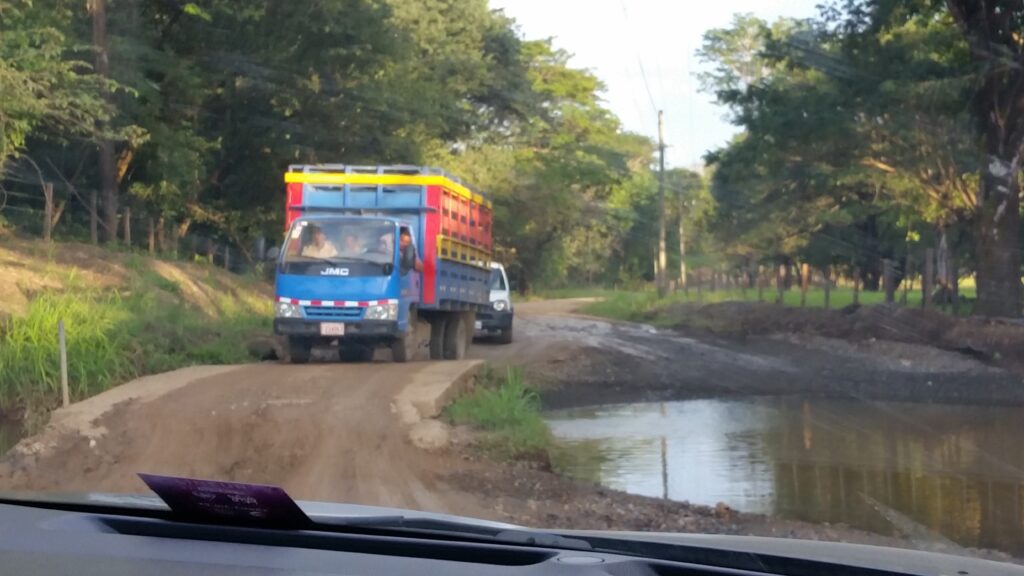
Other Road Users
Roads in Costa Rica can be shared with a variety of other users.
Farmers & Livestock
In Costa Rica’s countryside, you may come across farmers driving tractors or hauling produce. They move at a slower pace, and while it may require a bit of patience, take it as a time to appreciate the beauty around you. Livestock like cows, horses, and even pigs often roam freely, so stay alert—especially in the more remote areas where they might appear unexpectedly.
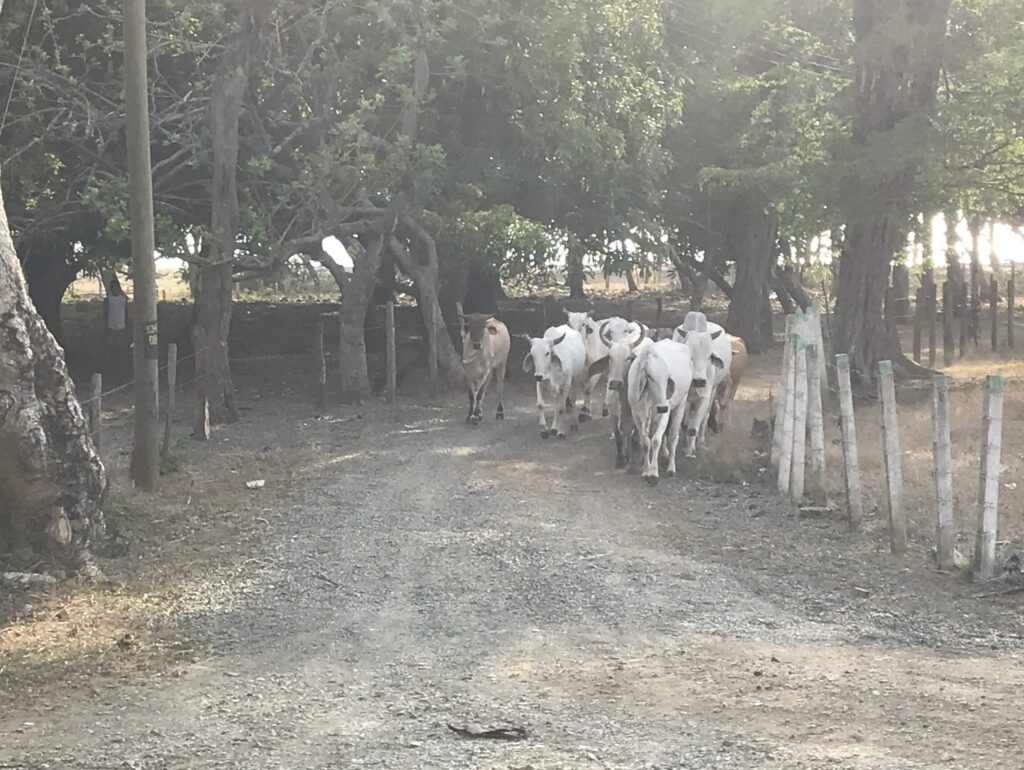
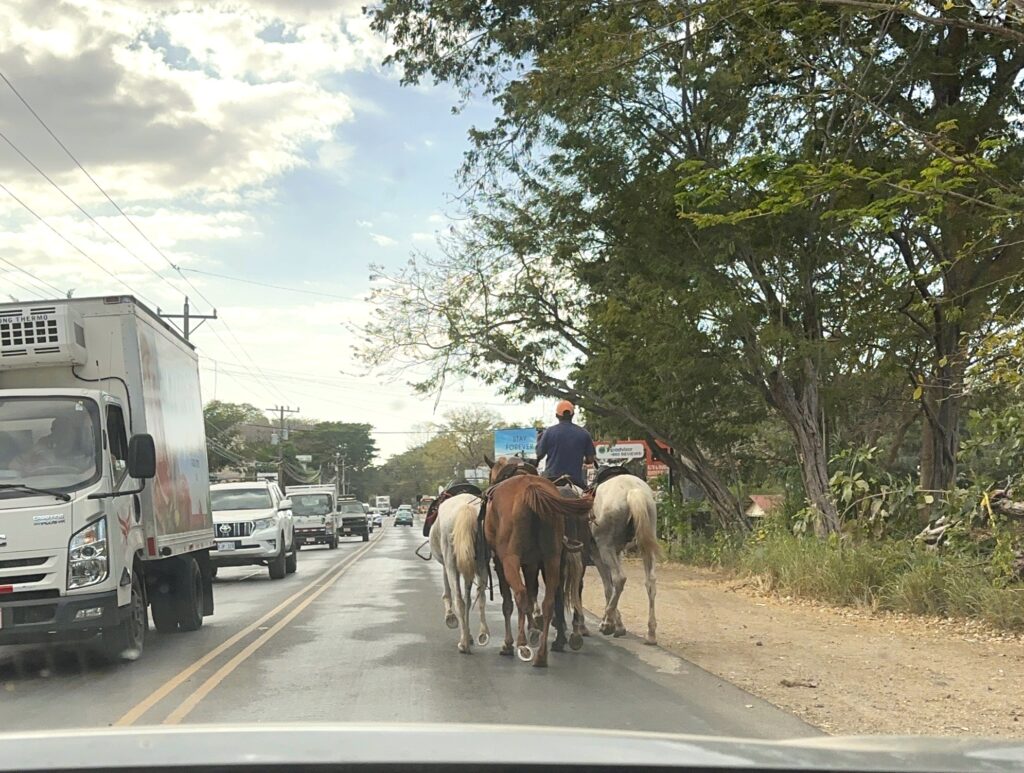
Pedestrians
Pedestrians frequent Costa Rica’s roads. Since many roads lack shoulders where walking would be safer, it’s important to be vigilant for pedestrians. Give pedestrians plenty of space and slow down when passing.
Whether they’re on a busy street or a quiet rural road, always be ready to stop if needed. It’s important that tourists show respect for the locals and their way of life.
Motorcyclists
Motorcycles are an essential part of Costa Rican traffic, especially in the busy towns and cities where they navigate around congestion. Be aware of their presence as they may weave through traffic or use narrower paths, and always give them space when passing.
You may come across multiple people on a motorcycle so allow them extra space in case anyone tumbles off. We’ve seen as many as 2 adults and 3 kids on one motorcycle driving along a rural dirt road.
Tractor-Trailers
In both rural and urban areas, you’ll encounter large tractor-trailers. These big vehicles can take up more space and make tight turns, so it’s important to pass with caution. If you see a left signal flicked by the driver, it’s usually a sign that it’s safe to pass.
Always remain cautious if taking them up on their offer, especially on winding roads or when visibility is limited. Remember, your opinion of safe and theirs may not be the same.
Wildlife
Costa Rica’s wildlife is one of the country’s greatest treasures, and sometimes that means sharing the road with them. Monkeys, sloths, birds, and reptiles may wander into your path, especially near national parks or in rural areas.
Most wildlife crossings happen at dawn or dusk, so slow down and be prepared to stop. You may even find yourself in a traffic jam caused by an iguana sunbathing on the road, as we’ve seen more than once! Approach with patience and respect for Costa Rica’s incredible wildlife.
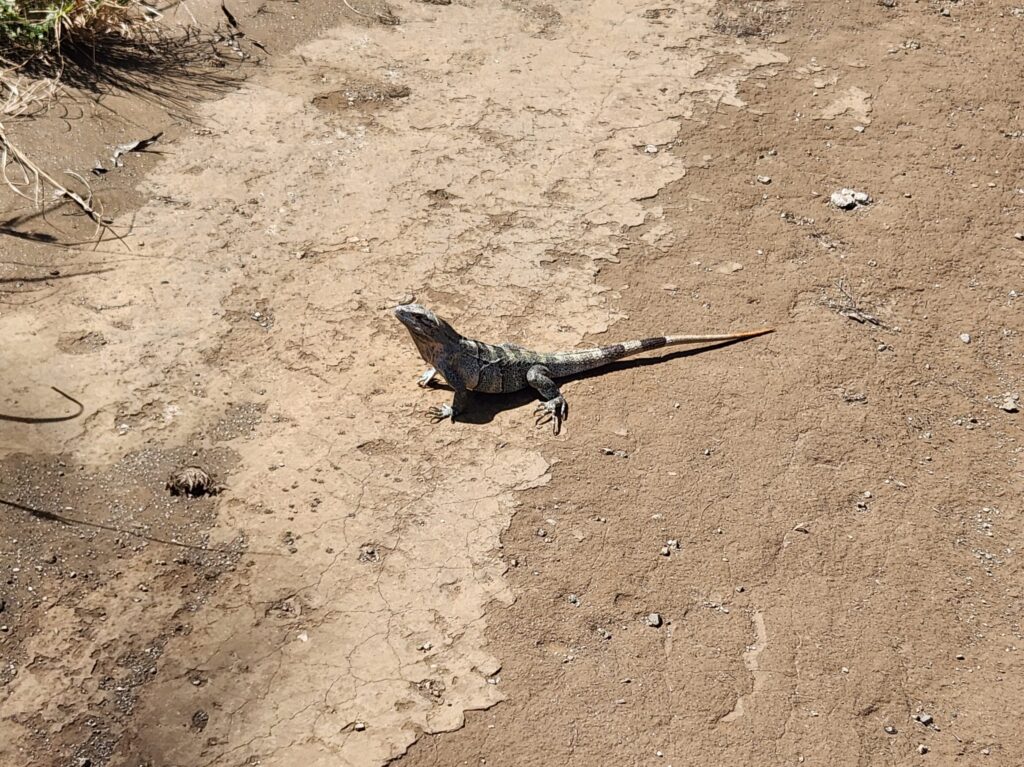
Passing
Passing can often feel like a high-stakes manoeuvre in Costa Rica. It’s not uncommon to witness drivers making risky passes—especially around blind corners, on steep hills, or when visibility is poor.
In many Latin American countries, driving habits can be an eye-opening experience for tourists from outside the region, and while Costa Rica may be calmer than some places, passing remains an area where local drivers take chances.
Our best advice? Keep plenty of space between you and the car ahead. This gives you more time to react and allows those attempting to pass to slide in safely when necessary, helping to keep everyone’s journey moving.
Accidents & Checkpoints
Understanding how to handle car accidents and police checkpoints is essential for a smooth and stress-free driving experience. Knowing the right steps to take can help you navigate these situations with confidence and ease.
Accidents
If you find yourself in a car accident in Costa Rica, stay at the scene and leave your vehicle where it is to ensure a proper investigation by authorities. It’s the law for vehicles involved in accidents to stay put, even if blocking traffic.
Call 911 right away to report the accident and get medical assistance if needed. Exchange insurance and contact information with all parties involved, and capture photos of the scene to document any damages or injuries.
Next, you’ll want to reach out to your rental company or insurance provider to report the incident. Remember to get a copy of the police report—it’s essential for your insurance claim.
During a journey between La Fortuna and San Jose, we experienced a side-swipe hit and run. We quickly called our credit card insurance for guidance. They informed us that a police report was necessary if damages exceeded $1000. Unsure of the damage, we headed to the local police station to report the incident.
There was confusion due to the stay in place rule we weren’t aware of, compounded by the language barrier not uncommon of a remote, non-tourist town (we spoke minimal Spanish and they spoke no English). Now, we know better and our advice to you is simple: leave your vehicle exactly where the collision occurred and call 911 for assistance.
Police Checkpoint
We haven’t come across any police checkpoints on our travels in Costa Rica; however, they do occur—more commonly near borders with other countries. We’ve been told that as a tourist, you’ll likely be waved through or simply asked about your destination.
If stopped, the officer may ask to see your passport and if there’s any language barrier, a phone translation app can help with communication. Just remain calm and cooperative, and you’ll be back in motion in no time.
Security & Parking
Driving through Costa Rica is an exciting adventure, and with a little attention to security and parking rules, you can focus on enjoying the journey.
Security
Always lock your car while driving or parked and keep valuables out of sight when leaving your vehicle. Costa Rica is generally considered fairly safe, but petty-theft can be problematic if made easy. For peace of mind, choose secure, well-lit parking areas or lots with parking attendants.
Many of Costa Rica’s popular tourist attractions, towns, and beaches have friendly parking attendants ready to help guide you to a spot and keep an eye on your vehicle for just a few dollars (typically $1 to $4 USD or around 500 to 2000 colones).
While they’ll let you know their price, if you don’t have the exact amount, they’re often happy to accept a little less. Remember, this may be their only source of income, and their affordable service provides peace of mind, ensuring your car stays safe while you enjoy the beauty of Costa Rica!
Stay aware, but don’t let security concerns take away from the magic of exploring this stunning country! Overall, security isn’t a major risk factor in Costa Rica – just be smart.
Public Parking
Costa Rica is committed to keeping its streets safe and orderly, and as part of that effort, traffic police (Transito) are cracking down on illegal parking. If you park in prohibited areas, you might return to find a fine waiting for you and your license plate removed.
For rental cars, this could mean additional fees from the rental agency, and if it’s your own vehicle, retrieving your plate could take weeks.
To avoid any setbacks, steer clear of parking at bus stops, loading zones, yellow lines, or fire hydrants… Even waiting for a few minutes could lead to fines. Parking on beaches is a no-go, and national parks may have extra no-parking areas to protect wildlife and sensitive areas.
Stay mindful of where you park and respect the rules for a smooth experience!
Car Seats for Young Travellers
In Costa Rica, ensuring the safety of your little explorers is a top priority. Infants under 1 year old must travel in rear-facing car seats, while toddlers aged 1 to 4 can ride in a front-facing seat with side-impact protection.
As your children grow, booster seats become the next step. A high-back for those 4 to 6 years old, and backless boosters for children 6 to 12 years old.
Once your child is taller than 145 cm, they can use the vehicle’s seat belts, with their feet resting firmly on the floor. Costa Rica’s child safety regulations are designed to keep your family secure while exploring the beauty of the country. Understanding these requirements ensures your adventure is not only exciting, but also safe for everyone.
If you’re renting a car and have little ones in tow, be sure to check ahead of time that the right seat is available (usually at an extra charge), unless you are bringing your own. DiscoverCars.com allows you to filter car rental companies by the type of car seat they carry.
We recommend bringing your own car seat or booster seat as the ones from car rental agencies are often the most basic and may not be very comfortable for longer trips.
For in-depth information on Costa Rica’s car seats laws and our recommendation for a great travel car seat, click here!
Filling Up
When driving in Costa Rica, it’s important to be prepared for the cost of fuel as it can impact your travel budget. Knowing the ins and outs of gas stations can make for a more relaxed and hassle-free event.
Average Gas Prices:
As of early 2025, the cost of gasoline hovered around $1.40 USD per litre (around 670 colones per litre). Diesel fuel is typically a little cheaper than regular gas. On the upside, prices are government regulated so you don’t need to waste time looking for the best deal!
Gas Stations:
Costa Rica has plenty of gas stations scattered across major cities and highways. However, in more remote areas or national parks, finding fuel stations can be tricky, so always make sure to fill up when you have the opportunity.
In smaller towns, gas stations may also be less frequent, and they often close early in the evening, so it’s good to plan your fuel stops ahead of time.
Gas stations typically take cash or credit cards and are full-serve. Just double check that the pump is set back to zero before they start pumping your gas to ensure you pay the right price. We usually leave a small tip as a thank you for the service!
The Waze App: Navigate with Confidence
The Waze app is considered the best navigational app to use in Costa Rica. With real-time traffic updates, road conditions, and faster routes at your fingertips, Waze keeps you moving. It uses user-generated content to alert you to roadblocks and accidents.
When adventure takes you off the grid, or your route has spotty reception, you can download maps for offline use. This feature ensures you’re always ready to explore, even in areas with limited signal.
We’ve discovered that the Waze app is a true companion for exploring Costa Rica, offering a more reliable experience than Google Maps. While Google Maps might occasionally lead you down unexpected back roads or to turns where there’s no road at all, Waze stays on track, guiding you accurately along the best routes.
Its offline feature is a game-changer as it’s not uncommon to find yourself in areas without reception.
Renting a Car in Costa Rica with DiscoverCars.com
It can be daunting searching for the best car rental, but by using DiscoverCars.com, your search will be a little easier. Here you to compare top options, from local and international companies, so you can find exactly what suits your travel style and fits your budget.
While scrolling through the possibilities, remember that a great deal often comes with a trusted company and if something sounds too good to be true, it likely is. To ensure a smooth journey from the start, choose well-known rental companies with ratings of 8 or higher, for peace of mind.
We like DiscoverCars.com because it makes renting a car in Costa Rica super easy and hassle-free. The site lets us compare a wide range of cars from trusted rental companies, so we always feel confident in our choice. We like that the prices are clear and the process is straightforward.
If we are considering a rental from a lesser-known company, we make sure to do some internet sleuthing to see what reviews we can find. Some companies will show ridiculously low rates then try to get you with hidden fees at time of pick up. For this reason, we usually go with the best option and price point from a well-known company or a local company with ample excellent reviews.
Give DiscoverCars.com a try for your next Costa Rican adventure! For more on renting a car, check out our Complete Guide to Renting a Car in Costa Rica.
15 Essential Tips for Driving in Costa Rica
Driving in Costa Rica is an exciting experience as it lets you explore wherever and whenever you desire. Here are 15 key points to help you drive safely and confidently:
- Carry Your Passport: It’s wise to carry your passport in the event of an accident or police stop.
- Drinking & Driving: The blood alcohol limit in Costa Rica is the same as several European countries, but lower than Canada and the US. Keep this in mind when considering what your drink limit should be if planning to get behind the wheel.
- Best Vehicle for Adventurers: Many rural roads in Costa Rica can be poorly maintained, especially in the rainy season. Renting a 4×4 vehicle is essential for navigating rough terrain and sometimes for experiencing the best off-the-beaten-path beaches!
- Directions are Literally Directions: Physical addreses don’t exist. Directions are usually given as a distance, or time passed a landmark or street corner.
- Use Extra Caution in Rainy Season: May to November is rainy season. Roads can get slick and certain areas may be flooded. Always check the weather forecast and be cautious on wet roads. Landslides and washouts may also occur. Pro Tip: Make sure your windshield wipers are working properly!
- Stay Focused When Driving at Night: Stay alert for livestock, wildlife, and pedestrians. Many roads outside tourist areas (and often within) can be narrow, winding, and lack shoulders, with potholes and no streetlights.
- One Lane Bridges: Take turns. It’s first come, first serve.
- Flashes from Oncoming Traffic: Oncoming driver’s may flash their lights to let you know that there are obstacles, like wildlife or livestock, on the road or a police presence.
- Be Prepared for Wildlife: Watch out for animals like monkeys, sloths, and iguanas that may wander across the road, especially in rural areas. It’s not uncommon to see a lineup of cars waiting for a large, sunbathing iguana to move off the road.
- Watch for Passing Vehicles: Drivers may pass with without due care. Maintain a safe distance from the vehicle in front of you to allow time to react and give space to those hasty lane passers.
- Keep Your Vehicle in Place: If in an accident, it’s the law to leave your vehicle exactly where the accident occurred, even if blocking traffic.
- Protect Your Vehicle: Leave valuables out of sight, lock doors, and seek out secure parking spots.
- Protect Your Kids: Ideally bring your own compact car seat or booster seat to ensure your child is adequately protected and comfortable. Remember the more comfortable they are, the happier they’ll be to ride the roads, which will help the whole family have the best experience possible!
- Map Out Gas Stations: Know where to get gas before heading out if running low or venturing into remote areas.
- Use Offline Maps: While GPS systems are helpful, it’s a good idea to have offline maps on your phone as a backup, especially when heading to remote areas where cell service might be spotty.
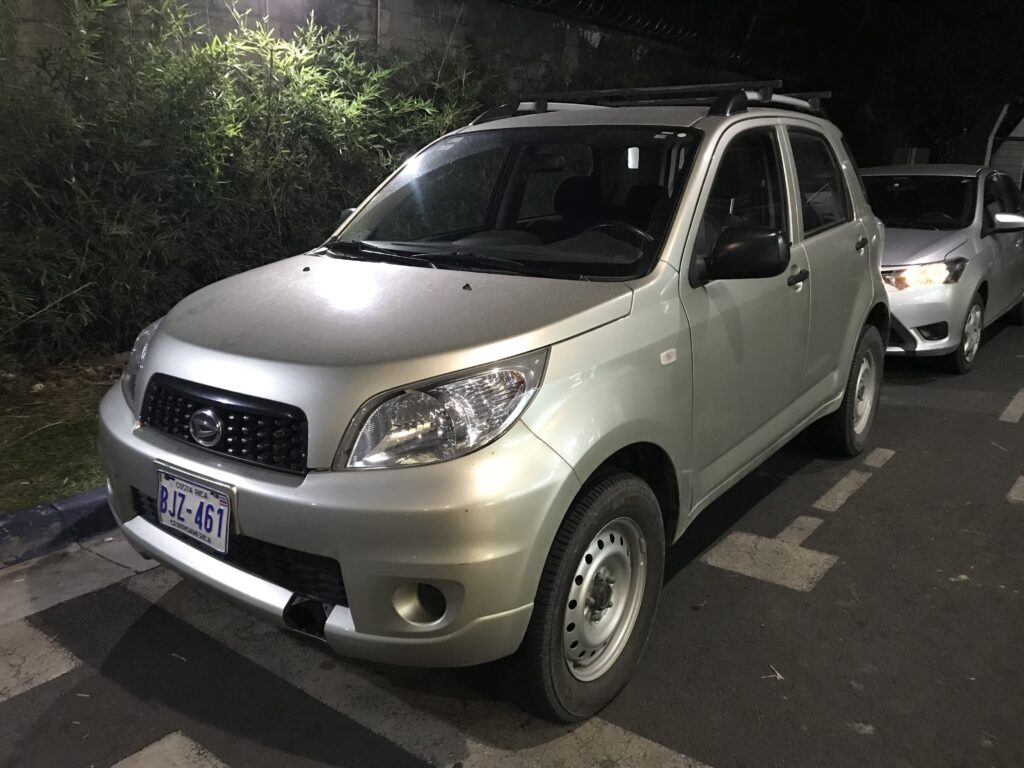
Now You’re All Set for Driving in Costa Rica!
Driving here has always felt safe, relaxed, and easy-going, outside the San Jose area anyway. The drivers are generally calm and considerate, making the roads feel welcoming and stress-free, unlike most other Latin American countries we’ve visited. It’s an adventure on every corner, and with a vehicle, the whole country feels like it’s at your fingertips.
Your travels through this beautiful country awaits, and the freedom to explore is now in your hands. We hope our “Driving in Costa Rica: What you need to know” guide has inspired you to embark on the adventure of a lifetime and experience your Out Roaming Life!
Ready to plan your next adventure? Head over to our Travel Resources page. It’s packed with the booking tools and travel essentials we swear by to make every trip amazing!
Life begins at the end of your comfort zone.
Neale Donald Walsch






